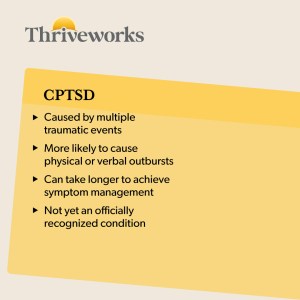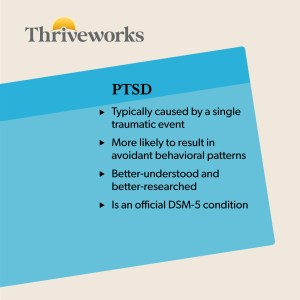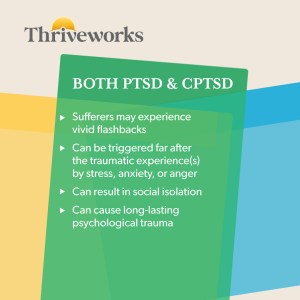
- CPTSD, while not an official condition, is often considered to be the result of multiple events that could result in the development of PTSD.
- When comparing CPTSD vs. PTSD, it’s noted that CPTSD sufferers may be more likely to lash out verbally or physically, and suffer from extremely low self-esteem.
- A CPTSD flashback can result in hyperarousal, reliving the memories of past events, anger, fear, and social isolation.
- While treatment approaches are extremely similar for both conditions, those with CPTSD may need extra time and support to work through the trauma caused by multiple adverse experiences.
Complex post-traumatic stress disorder (CPTSD) is a psychological condition that can develop in those who have experienced prolonged and/or repetitive traumatic events in their lives. In a CPTSD vs. PTSD matchup, these conditions may seem similar, but in reality, they are different in many ways.
Take a closer look with a CPTSD vs. PTSD matchup as we compare symptoms, contributing causes, and more between these two mental health conditions.
How Is CPTSD Different from PTSD?
While examining the characteristic of CPTSD vs. PTSD, it’s important to keep in mind that CPTSD is not an official clinical diagnosis, or a separate diagnosis. It’s also not to be confused with chronic PTSD, which is just PTSD that has persisted for 3 months or more.
Instead, CPTSD is a pseudo-term, meaning it’s commonly used but not “officially” recognized by sources such as the DSM-5. When differentiating between CPTSD vs. PTSD, CPTSD is typically applied to people who have the classic symptoms of PTSD, but instead of a single event that triggers their diagnosis, there are numerous traumatic events. These events create more complex symptoms that may be more difficult to work through.
Why Is CPTSD Not Recognized?
CPTSD is not recognized officially because it’s only been studied recently. It’s only been recognized as a specific subset for a short period of time and isn’t included in the DSM-5. For right now, trauma is being researched in a different way than it was in the past—and more intensely.
CPTSD vs. PTSD: Is CPTSD More Severe?
CPTSD is sometimes more severe — it depends on the person, their symptoms, and the impairments caused by their symptoms. As stated above, numerous traumatic events could be more intense and damaging than a single event. With this in mind, people with CPTSD may feel more distrustful, highly reactive, and intensely emotional when comparing CPTSD vs. PTSD symptoms.
Hello, we're here to help you
We provide award-winning mental health services nationwide, with flexible scheduling & insurance coverage. Start your journey this week.
What Are the Symptoms of Complex PTSD?
Because CPTSD isn’t a diagnosis, there’s no official list of symptoms. But when contrasting CPTSD vs. PTSD, the list of symptoms will overlap. Because the trauma has happened over and over again, some of the symptoms of CPTSD may be more related to self-image and a negative internal dialogue.
The symptoms of complex PTSD include:
- Recurrent, unwanted distressing memories of the traumatic experience(s)
- Reliving the traumatic experience(s) as if it were happening again (flashbacks)
- Upsetting dreams or nightmares about the traumatic experience(s)
- Severe emotional distress or physical reactions to things that are reminiscent of the traumatic experience(s)
- Attempts avoid thinking or talking about the traumatic experience(s)
When the central nervous system is honed over time to experience and guard against trauma, someone with CPTSD may not have a way to reality check what they feel. Without treatment, these visceral reactions and hypersensitivity make relationships and new experiences harder to enjoy, especially if these experiences have been a source of pain in the past.
When looking at CPTSD vs. PTSD, CPTSD sufferers may have more severe symptoms than those with PTSD, because it’s harder to differentiate prolonged exposure compared to between a single traumatic event.



Does CPTSD Cause Dissociation?
CPTSD can cause dissociation—this isn’t a defining factor but should be considered. For any kind of traumatic experience, it can feel like the environment around the individual isn’t real. This is the body’s way of disassociating to reduce the impact of trauma. An intense dissociative experience can be highly dangerous, and for some people, difficult to return from.
What Does a CPTSD Episode Look Like?
The symptoms of a CPTSD episode include:
- Hyperarousal or hypoarousal (sharpening or dulling of one or more of the five senses)
- Self-talk, such as a negative internal monologue
- Self-image issues and low self-esteem
- Intense memories of sounds, smells, and other stimulus
The flashbacks or “episodes” that are often portrayed in films and other media are typically inaccurate. These flashbacks don’t occur out of nowhere. This is the same for CPTSD and for PTSD sufferers—as these individuals have been managing their symptoms somehow and then, for whatever reason, they begin to lose their ability to tread water.
A spontaneous loss of reality also isn’t really an accurate way to describe or depict a PTSD flashback. CPTSD may be caused by repeated trauma from childhood. When someone experiences abuse, neglect, domestic violence, or another traumatic experience, the message taken in by the brain is often “I don’t matter.”
When stacking CPTSD vs. PTSD against each other, there’s another key difference: An individual who experiences repeated traumatic events may suffer from low self-esteem as their self-image is repeatedly damaged over time.
Someone with CPTSD may express this emotional pain more than someone with PTSD by:
- Lashing out verbally and/or physically
- Maintaining heightened distrust in personal relationships
- Demonstrating a high sensitivity to rejection from others, whether real or perceived
When looking at CPTSD vs. PTSD, the external expression of a CPTSD sufferer’s internal experience might seem more reactive.
Is CPTSD on the Autism Spectrum?
No, CPTSD is not on the autism spectrum, and CPTSD and autism spectrum disorder (ASD) are not connected. Comparing CPTSD vs. autism, or CPTSD vs. PTSD, it’s important to remember that CPTSD is not an official diagnosis, but a term for PTSD caused by multiple traumatic events.
In comparison, autism is a neurodevelopmental disorder. It affects someone’s social interactions, communication skills, and behavior. Individuals with ASD may have challenges in social skills, repetitive or restrictive patterns of behavior, sensory sensitivities, and difficulties with communication.
It’s crucial to consult with qualified professionals, such as therapists or psychiatrists, who can conduct thorough evaluations and provide accurate diagnoses based on individual symptoms and experiences. They can help determine the appropriate diagnosis and develop tailored treatment plans based on specific needs.
Does CPTSD Get Worse with Age?
CPTSD may or may not get worse with age – it varies by person. If your symptoms are worsening, it’s important to seek treatment so that your quality of life does not deteriorate. Developing and maintaining the proper coping skills are essential for long-term symptom management of CPTSD and recovery from trauma.
Without a therapist, living with CPTSD can feel like you are white knuckling it all the time, and things that may seem small or significant to other people may feel like huge obstacles. But despite the setbacks, memories, and fears, overcoming traumatic experiences is entirely possible—and there are experts out there who are trained to help.











